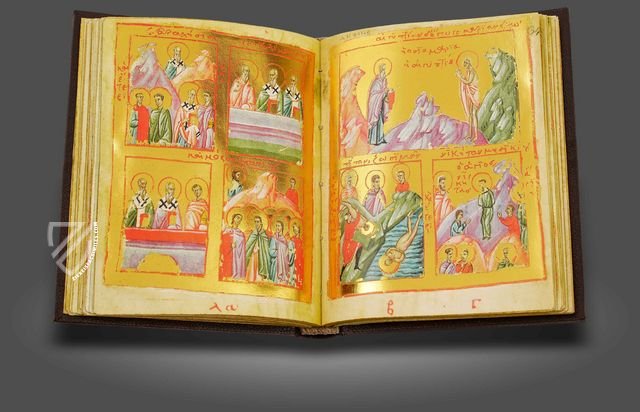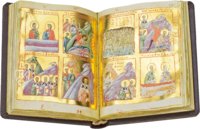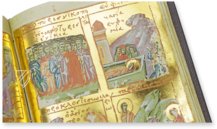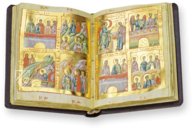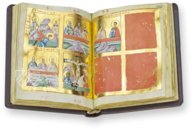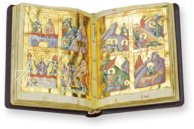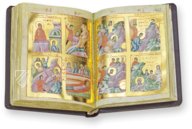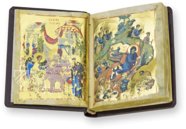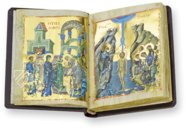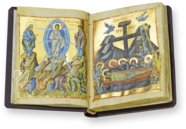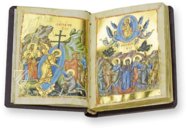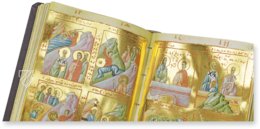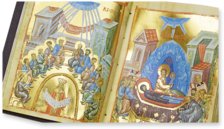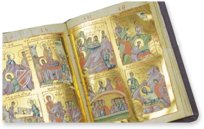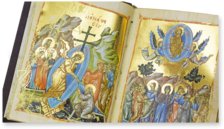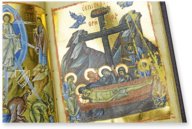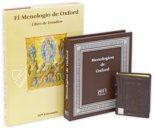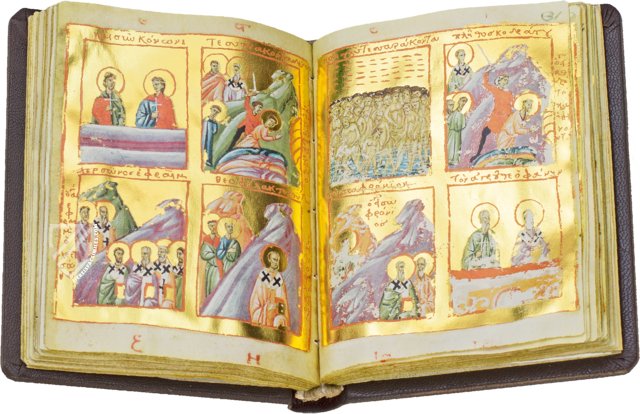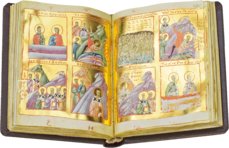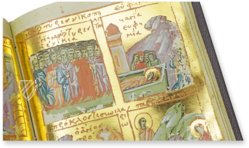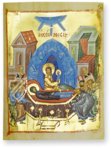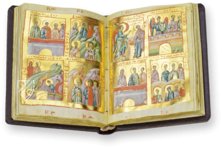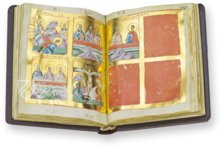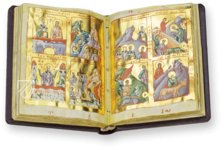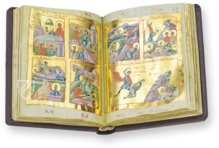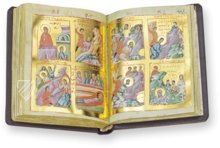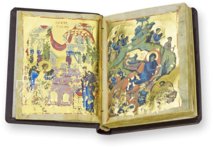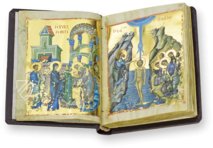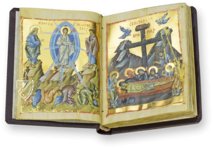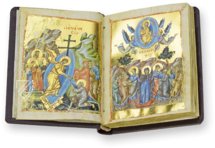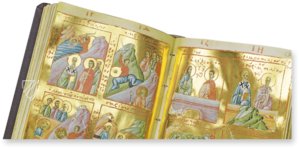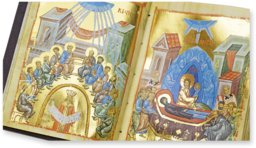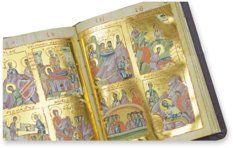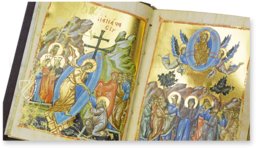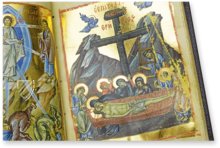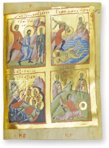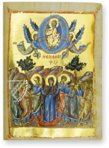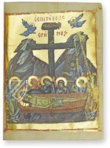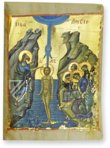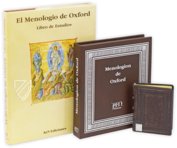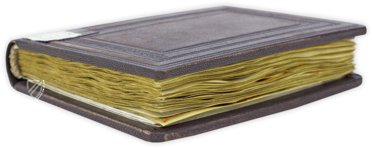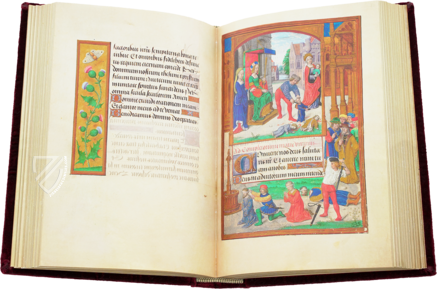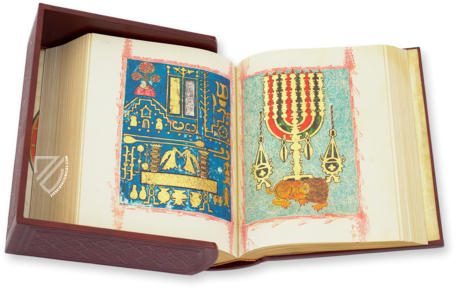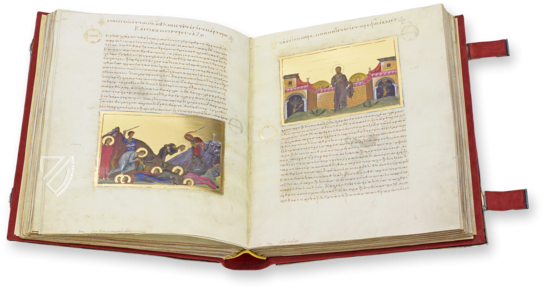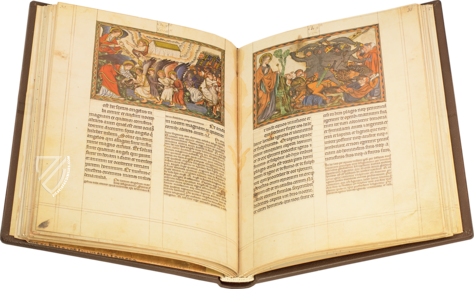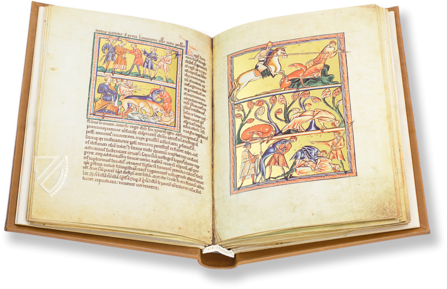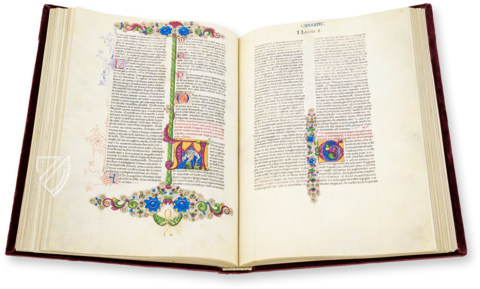Oxford Menologion
(1,000€ - 3,000€)
The Oxford Menologion, which gets its names from its modern abode in the Bodleian Library of Britain’s Oxford University, is a primary work of Byzantine book art with its 430 splendid miniatures set against a noble gold background. The masterpiece from ca. 1330 was probably created by a group of the most talented court artists of the Byzantine Empire. The manuscript is believed to be a commission of Demetrios Angelos Doukas Palaiologos, the Despot of Thessalonica, which was the second most important city of the empire after Constantinople.
Oxford Menologion
This so-called menologion is one of the most splendidly painted Byzantine manuscripts to survive to this day. The term menologion or menology first and foremost connotes a collection of detailed lives of the saints. These works are ordered according to the dates of feast- and memorial-days for the honored saints of the Orthodox Church and the Eastern Catholic Churches, who are celebrated throughout the liturgical year. A variant of the menologion with the lives of saints in abbreviated form is designated as a Synaxarion. The artful Oxford Menologion is just such a text. This codex numbers among the primary works of the excellent Byzantine style of illumination and is illustrated with over 430 splendid, richly furnished miniatures with noble gold leaf.
At the Behest of the Sovereign
The Oxford Menologion was made ca. 1330 at the behest of the Despot of Thessalonica, Demetrios Angelos Doukas Palaiologos (ca. 1297 – after 1343). He came from the Palaiogian dynasty and was the Despot of Thessalonica from 1322 to 1340. The city of Thessalonica was truly flourishing in the Byzantine Empire, experiencing a golden age, so to speak. After Constantinople, Thessalonica was the second most important city in the empire for a long time and was the Byzantine Emperors’ secondary seat of power. Thessalonica was not only one of the most important trade metropolises in the Orient, but was also a capital of knowledge and the arts. Wondrous architectural monuments filled the exceedingly wealthy city, as did artistic and literary masterpieces, some of which survive to this day and continue to cast their spell on beholders centuries later. The Oxford Menologion counts among the last evidence of this artistic golden age.
An Important Hagiographic Manuscript
The collection of abbreviated saints’ vitae was made for liturgical use in Byzantine church rites. The manuscript was written in Greek, in so-called “pearl script” on high-quality parchment sheets. Generally, a page consists of a six-line text, for which a painter created an image of a saint, group of saints, or a ceremonial act honoring the saints. The pictures, which number over 430, are an important example of hagiography, the veneration of saints, in the book art of Byzantium. Texts and images depict only half of the Byzantine liturgical year, only the months September through February are illustrated. Therefore, it can be assumed that a second volume of the work existed, which unfortunately went missing in the course of history.
Trailblazing Book Art
With his work, the artist who contributed the images to the Oxford Menologion created a breath-taking magnum opus of medieval Illumination. He depicted the people in his miniatures in a way that was revolutionarily perspectival and realistic. With that, he modified the flat method of representation that was commonly practiced in most illuminated codices of the Middle Ages. The gestures of the figures and their garments’ fall of folds were vividly depicted and the architecture portrayed in the background of the pictures attests to the unbelievably fine observational skills of the artist. The facial expressions of the people were also reproduced in a natural way, something that few artists were able to achieve to a similar extent during this period. This is a painting style that is sometimes identified as Macedonian Renaissance, in which artists drew heavily from great ancient examples.
Codicology
- Alternative Titles
- Menologion Bizantino de Oxford
El Menologio de Oxford
Menologion of Despotes Demetrios
Oxforder Menologion
Byzantinisches Menologium
Greek Menologion
Oxforder Bildmenologion - Size / Format
- 112 pages / 12.6 × 9.5 cm
- Origin
- Greece
- Date
- 14th century
- Epochs
- Style
- Genre
- Language
- Illustrations
- No less than 430 magnificent miniatures on gold backgrounds
- Content
- Collection of detailed lives of the saints ordered according to the dates of feast-days
- Patron
- Demetrios Angelos Doukas Palaiologos (ca. 1297 – after 1343), son of the Emperor Andronikos II Palaiologos
- Artist / School
- Two artists working in the Late Byzantine style
Oxford Menologion
Anointing of Christ's Body
Although less common in the West, the scene of Christ’s body being prepared for burial is extremely important in the tradition of Orthodox art. Christ is laid out upon an anointing-stone that appears as though it is floating. The Three Marys and another woman are pictured lamenting over the body as their male helpers look on, possibly including John the Evangelist and Joseph of Arimathea. Their golden halos contrast with the dark blues and blacks of this mournful scene.
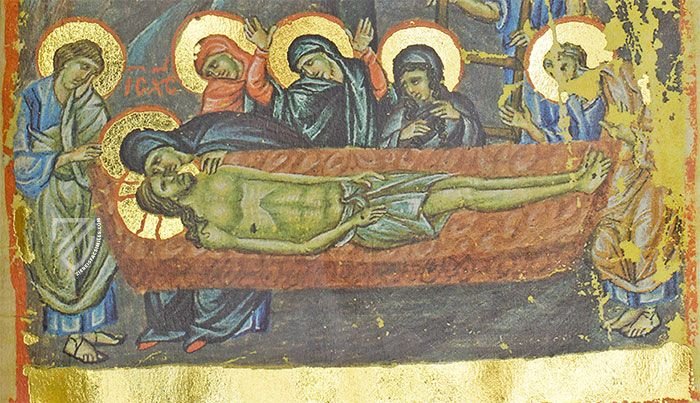
Oxford Menologion
The Death of the Virgin
This full-page miniature, although small, is remarkable for the richness of its adornment, especially the burnished gold leaf that dominates the page and gives the scene a timeless and spaceless feeling. Although slightly damaged, with some flaking gold leaf, it is an exemplary specimen of Byzantine art with a remarkable color palette.
The Twelve Apostles have miraculously assembled from their missionary work across the world and wear uniformly solemn faces. Within a bright blue mandorla flanked by angels, Christ appears dressed entirely in golden robes to signify that he is not there physically but in spirit. The baby he holds is the spirit of his mother, who is at peace and reunited with her son – their roles are now reversed as he holds her in his arms.
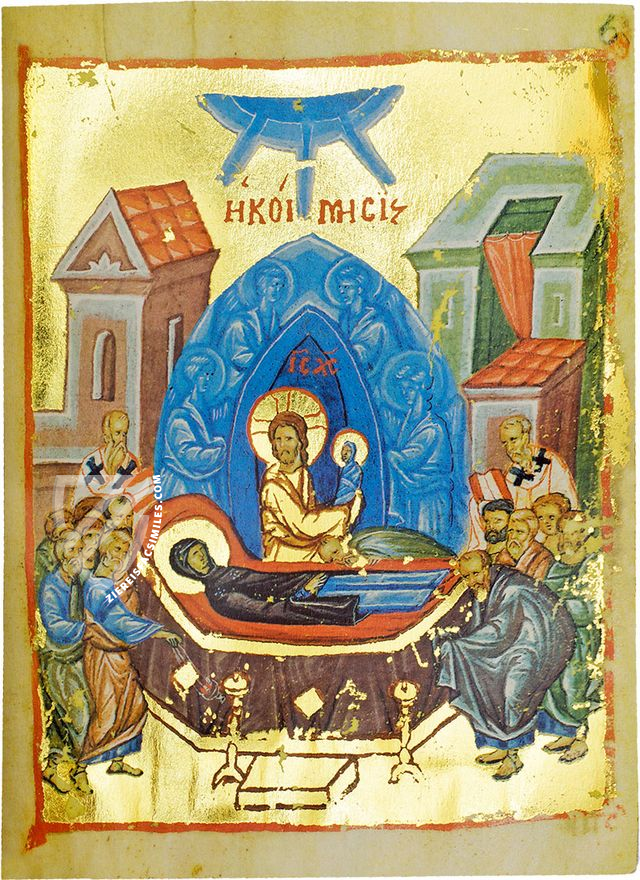
#1 El Menologio de Oxford
(1,000€ - 3,000€)
- Treatises / Secular Books
- Apocalypses / Beatus
- Astronomy / Astrology
- Bestiaries
- Bibles / Gospels
- Chronicles / History / Law
- Geography / Maps
- Saints' Lives
- Islam / Oriental
- Judaism / Hebrew
- Single Leaf Collections
- Leonardo da Vinci
- Literature / Poetry
- Liturgical Manuscripts
- Medicine / Botany / Alchemy
- Music
- Mythology / Prophecies
- Psalters
- Other Religious Books
- Games / Hunting
- Private Devotion Books
- Other Genres
- Afghanistan
- Armenia
- Austria
- Belgium
- Belize
- Bosnia and Herzegovina
- China
- Colombia
- Costa Rica
- Croatia
- Cyprus
- Czech Republic
- Denmark
- Egypt
- El Salvador
- Ethiopia
- France
- Germany
- Greece
- Guatemala
- Honduras
- Hungary
- India
- Iran
- Iraq
- Israel
- Italy
- Japan
- Jordan
- Kazakhstan
- Kyrgyzstan
- Lebanon
- Liechtenstein
- Luxembourg
- Mexico
- Morocco
- Netherlands
- Palestine
- Panama
- Peru
- Poland
- Portugal
- Romania
- Russia
- Serbia
- Spain
- Sri Lanka
- Sweden
- Switzerland
- Syria
- Tajikistan
- Turkey
- Turkmenistan
- Ukraine
- United Kingdom
- United States
- Uzbekistan
- Vatican City
- A. Oosthoek, van Holkema & Warendorf
- Aboca Museum
- Ajuntament de Valencia
- Akademie Verlag
- Akademische Druck- u. Verlagsanstalt (ADEVA)
- Aldo Ausilio Editore - Bottega d’Erasmo
- Alecto Historical Editions
- Alkuin Verlag
- Almqvist & Wiksell
- Amilcare Pizzi
- Andreas & Andreas Verlagsbuchhandlung
- Archa 90
- Archiv Verlag
- Archivi Edizioni
- Arnold Verlag
- ARS
- Ars Magna
- ArtCodex
- AyN Ediciones
- Azimuth Editions
- Badenia Verlag
- Bärenreiter-Verlag
- Belser Verlag
- Belser Verlag / WK Wertkontor
- Benziger Verlag
- Bernardinum Wydawnictwo
- BiblioGemma
- Biblioteca Apostolica Vaticana (Vaticanstadt, Vaticanstadt)
- Bibliotheca Palatina Faksimile Verlag
- Bibliotheca Rara
- Boydell & Brewer
- Bramante Edizioni
- Bredius Genootschap
- Brepols Publishers
- British Library
- C. Weckesser
- Caixa Catalunya
- Canesi
- CAPSA, Ars Scriptoria
- Caratzas Brothers, Publishers
- Carus Verlag
- Casamassima Libri
- Centrum Cartographie Verlag GmbH
- Chavane Verlag
- Christian Brandstätter Verlag
- Circulo Cientifico
- Club Bibliófilo Versol
- Club du Livre
- CM Editores
- Collegium Graphicum
- Collezione Apocrifa Da Vinci
- Comissão Nacional para as Comemorações dos Descobrimentos Portugueses
- Coron Verlag
- Corvina
- CTHS
- D. S. Brewer
- Damon
- De Agostini/UTET
- De Nederlandsche Boekhandel
- De Schutter
- Deuschle & Stemmle
- Deutscher Verlag für Kunstwissenschaft
- DIAMM
- Droz
- E. Schreiber Graphische Kunstanstalten
- Ediciones Boreal
- Ediciones Grial
- Ediclube
- Edições Inapa
- Edilan
- Editalia
- Edition Deuschle
- Edition Georg Popp
- Edition Leipzig
- Edition Libri Illustri
- Editiones Reales Sitios S. L.
- Éditions de l'Oiseau Lyre
- Editions Medicina Rara
- Editorial Casariego
- Editorial Mintzoa
- Editrice Antenore
- Editrice Velar
- Edizioni Edison
- Egeria, S.L.
- Eikon Editores
- Electa
- Emery Walker Limited
- Enciclopèdia Catalana
- Eos-Verlag
- Ephesus Publishing
- Ernst Battenberg
- Eugrammia Press
- Extraordinary Editions
- Fackelverlag
- Facsimila Art & Edition
- Facsimile Editions Ltd.
- Facsimilia Art & Edition Ebert KG
- Faksimile Verlag
- Feuermann Verlag
- Folger Shakespeare Library
- Franco Cosimo Panini Editore
- Friedrich Wittig Verlag
- Fundación Hullera Vasco-Leonesa
- G. Braziller
- Gabriele Mazzotta Editore
- Gebr. Mann Verlag
- Gesellschaft für graphische Industrie
- Getty Research Institute
- Giovanni Domenico de Rossi
- Giunti Editore
- Graffiti
- Grafica European Center of Fine Arts
- Guido Pressler
- Guillermo Blazquez
- Gustav Kiepenheuer
- H. N. Abrams
- Harrassowitz
- Harvard University Press
- Helikon
- Hendrickson Publishers
- Henning Oppermann
- Herder Verlag
- Hes & De Graaf Publishers
- Hoepli
- Holbein-Verlag
- Houghton Library
- Hugo Schmidt Verlag
- Idion Verlag
- Il Bulino, edizioni d'arte
- ILte
- Imago
- Insel Verlag
- Insel-Verlag Anton Kippenberger
- Instituto de Estudios Altoaragoneses
- Instituto Nacional de Antropología e Historia
- Introligatornia Budnik Jerzy
- Istituto dell'Enciclopedia Italiana - Treccani
- Istituto Ellenico di Studi Bizantini e Postbizantini
- Istituto Geografico De Agostini
- Istituto Poligrafico e Zecca dello Stato
- Italarte Art Establishments
- Jan Thorbecke Verlag
- Johnson Reprint Corporation
- Josef Stocker
- Josef Stocker-Schmid
- Jugoslavija
- Karl W. Hiersemann
- Kasper Straube
- Kaydeda Ediciones
- Kindler Verlag / Coron Verlag
- Kodansha International Ltd.
- Konrad Kölbl Verlag
- Kurt Wolff Verlag
- La Liberia dello Stato
- La Linea Editrice
- La Meta Editore
- Lambert Schneider
- Landeskreditbank Baden-Württemberg
- Leo S. Olschki
- Les Incunables
- Liber Artis
- Library of Congress
- Libreria Musicale Italiana
- Lichtdruck
- Lito Immagine Editore
- Lumen Artis
- Lund Humphries
- M. Moleiro Editor
- Maison des Sciences de l'homme et de la société de Poitiers
- Manuscriptum
- Martinus Nijhoff
- Maruzen-Yushodo Co. Ltd.
- MASA
- Massada Publishers
- McGraw-Hill
- Metropolitan Museum of Art
- Militos
- Millennium Liber
- Müller & Schindler
- Nahar - Stavit
- Nahar and Steimatzky
- National Library of Wales
- Neri Pozza
- Nova Charta
- Oceanum Verlag
- Odeon
- Orbis Mediaevalis
- Orbis Pictus
- Österreichische Staatsdruckerei
- Oxford University Press
- Pageant Books
- Parzellers Buchverlag
- Patrimonio Ediciones
- Pattloch Verlag
- PIAF
- Pieper Verlag
- Plon-Nourrit et cie
- Poligrafiche Bolis
- Presses Universitaires de Strasbourg
- Prestel Verlag
- Princeton University Press
- Prisma Verlag
- Priuli & Verlucca, editori
- Pro Sport Verlag
- Propyläen Verlag
- Pytheas Books
- Quaternio Verlag Luzern
- Reales Sitios
- Recht-Verlag
- Reichert Verlag
- Reichsdruckerei
- Reprint Verlag
- Riehn & Reusch
- Roberto Vattori Editore
- Rosenkilde and Bagger
- Roxburghe Club
- Salerno Editrice
- Saltellus Press
- Sandoz
- Sarajevo Svjetlost
- Schöck ArtPrint Kft.
- Schulsinger Brothers
- Scolar Press
- Scrinium
- Scripta Maneant
- Scriptorium
- Shazar
- Siloé, arte y bibliofilia
- SISMEL - Edizioni del Galluzzo
- Sociedad Mexicana de Antropología
- Société des Bibliophiles & Iconophiles de Belgique
- Soncin Publishing
- Sorli Ediciones
- Stainer and Bell
- Studer
- Styria Verlag
- Sumptibus Pragopress
- Szegedi Tudomànyegyetem
- Taberna Libraria
- Tarshish Books
- Taschen
- Tempus Libri
- Testimonio Compañía Editorial
- Thames and Hudson
- The Clear Vue Publishing Partnership Limited
- The Facsimile Codex
- The Folio Society
- The Marquess of Normanby
- The Richard III and Yorkist History Trust
- Tip.Le.Co
- TouchArt
- TREC Publishing House
- TRI Publishing Co.
- Trident Editore
- Tuliba Collection
- Typis Regiae Officinae Polygraphicae
- Union Verlag Berlin
- Universidad de Granada
- University of California Press
- University of Chicago Press
- Urs Graf
- Vallecchi
- Van Wijnen
- VCH, Acta Humaniora
- VDI Verlag
- VEB Deutscher Verlag für Musik
- Verlag Anton Pustet / Andreas Verlag
- Verlag Bibliophile Drucke Josef Stocker
- Verlag der Münchner Drucke
- Verlag für Regionalgeschichte
- Verlag Styria
- Vicent Garcia Editores
- W. Turnowski Ltd.
- W. Turnowsky
- Waanders Printers
- Wiener Mechitharisten-Congregation (Wien, Österreich)
- Wissenschaftliche Buchgesellschaft
- Wissenschaftliche Verlagsgesellschaft
- Wydawnictwo Dolnoslaskie
- Xuntanza Editorial
- Zakład Narodowy
- Zollikofer AG

